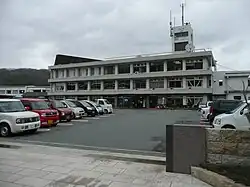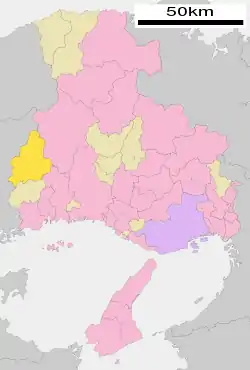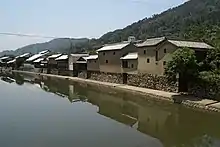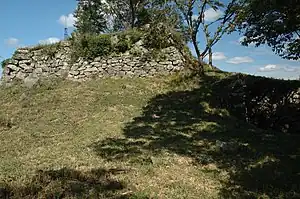Sayō
佐用町 | |
|---|---|
 Sayo Town Hall | |
 Flag  Chapter | |
 Location of Sayō in Hyōgo Prefecture | |
 Sayō Location in Japan | |
| Coordinates: 35°0′N 134°21′E / 35.000°N 134.350°E | |
| Country | Japan |
| Region | Kansai |
| Prefecture | Hyōgo |
| District | Sayō |
| Government | |
| • Mayor | Noriaki Anzako |
| Area | |
| • Total | 307.44 km2 (118.70 sq mi) |
| Population (March 31, 2022) | |
| • Total | 15,701 |
| • Density | 51/km2 (130/sq mi) |
| Time zone | UTC+09:00 (JST) |
| City hall address | 2611-1 Sayō, Sayō-chō, Sayō-gun, Hyōgo-ken 679-5380 |
| Website | Official website |
| Symbols | |
| Flower | Sunflower |
| Tree | Ginkgo biloba |
Sayō (佐用町, Sayō-chō) is a town located in Sayō District, Hyōgo Prefecture, Japan. As of 31 March 2022, the town had an estimated population of 15,701 in 6797 households and a population density of 51 persons per km2.[1] The total area of the town is 307.44 square kilometres (118.70 sq mi).
Geography
Sayo is located in the southwestern part of Hyōgo Prefecture in the basin along the Sayogawa River in the Chikusa River system. Approximately 80% of the town area is occupied by hills and forests. In the early morning from late autumn to winter, there is often a fog called "Sayo morning fog".
Neighbouring municipalities
Hyōgo Prefecture
Okayama Prefecture
Climate
Sayō has a Humid subtropical climate (Köppen Cfa) characterized by warm summers and cool winters with light to no snowfall. The average annual temperature in Sayō is 13.8 °C. The average annual rainfall is 1488 mm with September as the wettest month. The temperatures are highest on average in August, at around 25.9 °C, and lowest in January, at around 2.6 °C.[2]
Demographics
Per Japanese census data,[3] the population of Sayō has declined steadily over the 70 years.
| Year | Pop. | ±% |
|---|---|---|
| 1950 | 38,352 | — |
| 1960 | 32,455 | −15.4% |
| 1970 | 26,410 | −18.6% |
| 1980 | 24,874 | −5.8% |
| 1990 | 23,827 | −4.2% |
| 2000 | 22,337 | −6.3% |
| 2010 | 19,273 | −13.7% |
History
_aftermath_in_Sayo_21.jpg.webp)
Sayō is located in ancient Harima Province, and the name appears in the Heian period Engishiki records. From the Kamakura period Hirafuku-juku prospered as a post town on the Inaba Kaidō, the main highway from Kyoto and Osaka to Inaba Province in western Japan, and in the Nanboku-chō period, the Akamatsu clan built Rikan Castle overlooking the town. In 1600, the Ikeda clan of Himeji Domain built three-story tenshu and established a cadet domain called "Hirafuku Domain" for Ikeda Teruoki. In 1697, the Tokugawa shogunate established Mikazuki Domain,who ruled parts of Sayō until the Meiji restoration in 1871. The villages of Sayo andHirafuku were established with the creation of the modern municipalities system on April 1,1889. Both were elevated to town status on October 1, 1928. On March 1, 1955, Sayo and Hirafuku merged with the neighboring villages of Ekawa, Ishii and Nagatani to form the town of Sayō On October 1, 2005 the towns of Kōzuki, Mikazuki and Nankō, all from Sayō District were merged into Sayō.
In August 2009, around a dozen people in Sayo are dead or missing as a result of flash floods due to Tropical Storm Etau, according to NHK. According to the Japan Times, 390 homes were flooded.
Government
Sayō has a mayor-council form of government with a directly elected mayor and a unicameral town council of 14 members. Sayō, together with the city and district of Akō, contributes one member to the Hyogo Prefectural Assembly. In terms of national politics, the town is part of Hyōgo 12th district of the lower house of the Diet of Japan.
Economy
Sayō has mostly a rural economy based on agriculture and forestry.
Education
Sayō has four public elementary schools and four public middle schools operated by the town government and one public high school operated by the Hyōgo Prefectural Department of Education. There is also one private middle school and one private high school.
Transportation
Railway
- Mikazuki - Harima-Tokusa - Sayo - Kōzuki
Highways
Local attractions
- Rikan Castle ruins, National Historic Site
- SPring-8, atomic physics research facility
Gallery
 SPring-8
SPring-8 Hirafukuneighborhood
Hirafukuneighborhood Hirafuku, scenery of the ridge of Sayō River
Hirafuku, scenery of the ridge of Sayō River ruins of Rikan Castle
ruins of Rikan Castle
References
- ↑ "Sayō town official statistics" (in Japanese). Japan.
- ↑ Sayō climate data
- ↑ Hyōgo population statistics
External links
 Media related to Sayō, Hyōgo at Wikimedia Commons
Media related to Sayō, Hyōgo at Wikimedia Commons- Sayō official website (in Japanese)